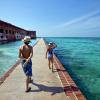Delray Beach draws more than 1 million visitors annually to its most popular attraction, its sandy shore. Other nearby natural attractions include the Wakodahatchee Wetlands, the Sandoway House Nature Center and the Loxahatchee National Wildlife Refuge. But on the opposite side of this South Florida destination lies the Everglades, a breathtaking collaboration of wetlands and wildlife unlike any place else on earth.
Nicknamed the “Village by the Sea”, Delray Beach is on Florida's east coast midway between West Palm Beach and Fort Lauderdale. It is a quaint collection of shopping and arts districts, resort hotels and residential neighborhoods that aim to preserve the charm of old South Florida. It is nestled between pristine beaches the Everglades ecosystem.
The 11,000-square-mile Everglades region supports dozens of federally protected and endangered species. The region stretches the length of South Florida and encompasses watery sawgrass prairies, cypress forests and mangrove marshes. It is home to more than 250 bird species, and its mix of freshwater and saltwater makes the Everglades the only place on earth where alligators and crocodiles live side-by-side. Everglades National Park, Big Cypress National Preserve, and state and local parks, let visitors explore the Everglades up close.
Wakodahatchee Wetlands
Without leaving Delray Beach visitors can have an Everglades experience. The Wakodahatchee Wetlands were constructed in 1996 as a means of conserving drinking water. Since then they have conserved more than 500 billion gallons of freshwater that, otherwise, would have been discarded. The wetlands attract alligators, turtles, frogs, fish and birds. More than 140 bird species have been spotted, including herons, egrets and sparrows. You’ll want to keep your camera ready as you stroll a three-quarter-mile boardwalk and take in all the sights.
"It's a slice of the Everglades," says Robert Nelton of Palm Beach County's water utilities department. "You'll see everything you would see in the Everglades but in a local residential area."
Delray Oaks Natural Area & the Morikami Museum
Nature is Delray Beach's primary draw. Besides the beach, visitors can also experience nature at the 24.5-acre Delray Oaks Natural Area, where large old oak trees mingle among palm warblers and other songbirds. Visitors also hike or jog concrete and bare earth trails. It doesn't stop there. Experience the beauty and nature of Japan without leaving Delray at Morikami Museum and Japanese Garden. It is a center for Japanese arts and culture, with rotating exhibitions in its galleries, tea ceremonies performed monthly in its Seishin-an tea house, an educational outreach program with local schools and organizations, and Japanese traditional festivals celebrated for the public several times a year.
Sandoway House Nature Center
And don’t miss the Sandoway House Nature Center, a historic 1936 beachfront home that features three live sharks in a 15,000-gallon aquarium, a shell collection and rotating exhibits of items such as shark jaws and fossils. The gardens are also representative of natural Florida habitats.
Loxahatchee National Wildlife Refuge
The Arthur R. Marshall Loxahatchee National Wildlife Refuge is only a short drive from Delray Beach. The 221-square-mile refuge is Palm Beach County's largest remnant of the Everglades. It features watery sawgrass prairies and cypress forests full of alligators and birds. It is a regional birding hub with species such as Purple Gallinule, Limpkin, Snail Kite, Red-shouldered Hawk and wading birds. Visitors can hike, bike, kayak and fish.
So, if you want a vacation that's more than just lounging on the beach, this is the place to go.






















